It beggars belief, but another year is done and dusted – poof, gone! It’s January and a new year means 12 months’ worth of holidays saved up. Hopefully now you can take some. This month is about getaways and shack life. The weather has improved dramatically and the daylight hours are long. These are perfect conditions. It’s time to get away and enjoy some coastal fishing and a slower pace for a while.
If you don’t have a shack on one of Tasmania’s awesome coastal areas, odds are you have a mate or family member that does. Beg, borrow or steal the keys and get a few days, or even a week away, and really get stuck into what the area has to offer. If you are reading this from the mainland, dive into the many accommodation sites online and find a place to come and relax and catch some tasty eating fish. You’ll find it is as good a holiday destination as you will find on the big island, minus the traffic and crowds.
This time of year, the ambient water temperature has really started to spike and that has the inshore species on the move and actively feeding. The offshore crews are actively watching the East Australian Current as it rolls down past Sydney and the southern coast of Victoria. The fish life out the front of this current has been fantastic this year. The baitfish that mako sharks love have been thick. Some sharks were caught in December, so everyone’s keen for a good year.
In December, all the hype was up in the North Western tip of Tasmania – the Montague area and the waters around the islands. Robbins, Hunter and Three Hummock Island are the big three, but there are many more. The water and grounds in the middle of them and out the front of Woolnorth can be treacherous. The wrong weather and sea conditions need to be respected. Once you have a good understanding of the area, the rewards can be great. The fishing is spectacular on its day and the landscape and scenery are fantastic.
The species of fish available is varied and full of some real bucket list catches. Solid Tassie yellowtail kingfish and snapper have been the standouts for many seasons. The King George whiting and blue-spot flathead are also plentiful. Locals have known for many years that the sand flathead and gummy fishing is sensational as well.
The best access is out of the Montague River from Stoney Point, out to open sea to the east, and out around the front of Robbins Island. There are some very good squid grounds off Cape Elie off the Western tip of Robbins Island and up towards the next point. Those that like a feed of whiting can try along the sandy stretches of Ransonnet Bay along the top edge of Robbins.
You can come back under Robbins Island to the west and past Kangaroo Island to enter Boullanger Bay. However, you would need to be as brave as the three divers that swam a radioactive pool to open a valve stopping the Chernobyl disaster from being eleventy squillion times worse. To come under Robbins without any local knowledge and a full tide is tempting the same tragic fate.
The allure is the water movement around Woolnorth and the islands and rocky outcrops. This is where the kingfish are in good numbers. When they turn on, they’re great angling. These fish are not guaranteed and can be as frustrating as any species to get a hook-up on any given day. The key seems to be the moving water either side of the tide. Hooking them up is only the first battle – they will fight tooth and nail to bring you undone on the rocky outcrops and craggy bottoms, which they like to haunt in the area.
The area further into the water between the islands is known as Walker Channel and links up with Hope Channel to split Hunter Island on the port side heading north, and Three Hummock to starboard. These areas hold good numbers of flathead and gummy sharks, but you must have your wits about you at all times. Sand bars and tidal flow will catch the unwary.
Snapper and kingfish can be found on the top side of Three Hummock from North West Cape across to Cape Rochon with the amount of water moving over the bommies making it tricky to fish. This calls for some team work –the skipper should maintain boat position as the angler pitches big paddle-tail soft plastics in and around the boils and structure.
Clearing Cape Keraudren at the northern tip of Hunter Island, head west and you will see an island out to sea that has some very interesting bottom structure. We went out to the island recently to explore and believe that it holds some very big kingfish. We spent some time sounding the area and looking for some clefts and rock shelves to drag some livies on the down rigger later in the year. Whatever you do, don’t get on the island. The island is an albatross nesting ground and is off limits.
The Fleurieu Group of islands, as they are known collectively, are worth exploring and getting to know. You can do so by making sure you pick the weather, explore each island and approach from every angle. There are some fabulous anchorages around all the islands and somewhere to hold up and stay overnight, given all weather.
Take soft plastics with you of every size and some bigger jigheads than you would ordinarily use. The current is mad at times. Take plenty of paternoster rigs and tie up some snelled Strayline rigs for baitfishing. Don’t forget some bigger sinkers for that as well. The easy rig plastic and stainless clips are handy for using bigger lead as a running sinker on braid line and wont chafe the braid. This won’t be an issue for the first fish or the second, but no one likes to lose a good gummy at the side of the boat due to sinker/line chafe.
If the weather allows and you can fish at anchor, set yourself up with some whiting rigs and the ability to berley on the sea floor. The whiting in the area are seriously mad and are extra oversized.
The North Coast has been fishing well from Sisters Beach right through to Badgers Head and the species count has been up. December fished very well and this looks set to continue right through January. Squid have been on fire along the coast and memories of the massive freshwater spill from the rivers are erased. They have been replaced by memories of epic squid sessions. Getting over some sheltered and broken ground has had boats finding their quotas very quickly.
These fish are one species that can take heavy fishing pressure – they’re basically the blowflies of the ocean. Squid don’t live for very long in the scheme of things. They don’t end up in the old age home for squid and are lucky to get to 12 months old before they die. The good news for Tasmania is that we see multiple spawning runs and this is when they can be targeted for good results.
When I speak of broken ground, I’m talking about the sort of bottom that is always covered by seawater even on the lowest of tides and holds good numbers of parrotfish and wrasse. The depth can vary from 4-10m and in good water conditions like we have now. You can see the bottom or at least the occasional light patches. The lighter patches are areas of smaller shale or sandy bottom mixed in with hard rocky reef – this is the broken ground.
Get your squid jigs in this area at this time of year and you have a good chance of finding a hungry pack of cephalopods. If you have hooked up a squid on a nice supple tipped rod, gently play the fish up out off the bottom and have your fishing buddies get a jig out over the back of where it was hooked. They are often lying in wait and move about in good numbers. With a little practice, you can work them up to the boat and have some serious fun.
Make sure you have a net, as landing squid without getting ink on your head or boat can be tricky without one. Berkley make a gun extendable net with the rubber netting that allows ease of jig removal. If you like to eat your squid, dispatch them as quickly as you possibly can. That will maximise their eating value. If you catch your squid and let them bash about a bucket or fish bin all day and leave them in the sun, they will be tough as old boots. Dispatch them swiftly and they’ll be much better eating. Look up a quick video of someone using an egi spike to get the job done.
The swift dispatching of fish is not only humane and the right thing to do, but it also negates any enzymes or other metabolites setting into the flesh and muscles, ruining the taste. It’s a very interesting subject – anything that maximises the flesh and eating quality of the fish you catch is a good thing.
There is a real buzz around this time of year off the East Coast and it’s all about mako sharks and stripy trumpeter. When you throw into the mix the blue-eye trevalla fishing, you have a great reason to visit the coast. The area from Musselroe Bay to Bicheno comes alive – all species are active during January. If you’ve never had the chance to fish for striped trumpeter or blue-eye trevalla, or don’t have a boat, you can still get out and have a go. There are several charter operators that can get you on the right track quick smart.
Stuart Blackwell from Musselroe Charters has a wealth of local knowledge and experience and is a gateway to the area. Stuart can also take groups up to The Furneaux Group of islands for fishing or scenic tours. The vessel he uses is a Tasmanian built rig for Tasmanian conditions, and also available for dive charters for divers with their own gear.
If you’re looking for a charter out of St Helens, look no further than Daniel Edwards and his 41ft Stebber, Cintra. Daniel is setting up to cater for all species around the state and specialises in deep sea fishing, including swords and bluefin. The vessel is built for comfort and will offer something a little different – top speed is 25 knots from her twin 375hp v8 cats and her cruise speed is a swift 17knots. Daniel is an experienced angler and skipper offering a premium experience.
If you have your own vessel and are looking to stock the freezer with some stripy and blue-eye, it’s crucial to have a range of baits. Store bought and frozen baits are a good start, but some fresh offerings are paramount. You can often find some fish on your sounder and mark fish, but they just won’t bite. This can be very frustrating, so don’t give up.
Local lads Graham and Damien Purton went out to the shelf and sounded up some good fish with their Simrad NSS 12 in about 300m. Calling them for blue-eye, they thought they were in for a great start. Trouble is, no one told the fish and they refused to play the game. They had some really good frozen baby squid, which normally do the trick. They just couldn’t get a bite out of the biomass below.
Not to be outdone and refusing to give up, they went back inside the shelf and put the big Simrad to work in 100-120m. They spotted some soundings of interest and dropped the squid baited rigs on these. Over a few drops they picked up a couple of stripy trumpeter, morwong and some gurnard. Damo had made note of when the tide was on the shift and mentioned they should head out and try the blue-eye with some fresh strip baits of gurnard flesh and some morwong scraps from the frames after they filleted them.
A word of caution about gurnard – they make great baits and are even ok to eat in their own right, but those spines on their back are painful with a capital P. They will make the toughest of individuals whinge and wince like a baby and cut a good day out on the water very short. Always wear a protective glove if you decide to take them on and fillet or make baits out of them. If you suffer the misfortune of getting spiked, the only respite is hot water. Don’t ask me why, but from personal experience, it’s the only relief.
If you do a lot of bottom fishing, you are from one of two schools. Either the gurnard never ever come into the boat and you have a very long nosed pair of pliers, or just cut them off, or you take the chance and deal with them. If you’re in the second school of thought, invest in a half reasonable 12V kettle. Keep it wrapped up somewhere in the boat with some strong pain medication. You might not get caught the first time, or the second, but one day you are going to get nailed and understand what all the fuss is about.
In the end, Damo and Graham headed back out to the deeper water where they sounded fish previously and dropped baits on the slack tide. The difference was like night and day. The fish nailed the fresh strip baits and were pulled up two or three at a time. Soon they had enough fish for a total of 13 and headed home. To top the trip off nicely, they had three decent cray in their pot, which they pulled on the way back to the ramp. The message here is, don’t give up and try something different until the conditions come back to you. Flogging a dead horse can lead to frustration when changing tack. Coming back to it at a different tide can work wonders.
The coastal areas around Swansea, Triabunna and Orford really come alive at this time of year. The holiday population swells with numbers of shack owners and tourists alike. If you have spent any time in these areas over the last five years, you will have noted remarkably how the numbers have grown. If you’re looking to go anywhere on the tight and twisty coastal road, allow plenty of time – nothing happens in a hurry on this road in the summer. Travel safe and patiently.
The boat ramps can be a feast or a famine, so be prepared to wait and be courteous. A lot of these anglers and boat owners are once or three times a year fishos, so be quick to offer some assistance rather than a sneer if held up. The coastal areas are full of fish as the water temperatures climb and the fish get active. Flathead are the target species of most holiday anglers and for good reason. They are relatively easy to catch and are fantastic to serve fresh with a summer salad.
In the shallow areas off Ninety Mile Beach you can get stuck into some sand flathead and access from Swansea itself, or out of the Swan River out through Swanick. The sand shifts here on occasion, so high tide is a better bet if you don’t have a good handle on the channel. The same can be said for accessing Great Oyster Bay from out of the Little Swanport Ramp. Swanport River mouth is a great spot for finding some Australian salmon or squid in the rocky points of the area.
It’s also a great launching spot to access Schouten Island and the passage, but don’t be fooled into thinking it’s shorter from here than the Swan. It looks like a short run across, but there is little difference in it. With certain weather conditions, the run from the Swan is a much more comfortable trip in smaller vessels. If you have the vessel to get to Schouten Island and the surrounding areas, you can access the grounds holding some good sized tiger flathead and striped trumpeter.
The converging currents are also a good spot to try for a mako shark as well. There are a lot of nutrients and bait that congregate out in front of the Freycinet Peninsula and Schouten Island. The convergence of food is a 7-Eleven for bigger predators like mako shark. While the success is often maximised by going out off the shelf in other areas, it can be replicated in closer here. The mako sharks are drawn in by the food on offer and a berley drift. An hour or two is enough to have something at the boat.
This month, if I put in over three hours off the passage, I have my bottom drip dragging. I dry my tears and three sharks turn up at once. The part-time seasonal angler can use an overhead reel like the Penn Squall 2-speed in either a 50 or 30 size to good effect. These reels are strong with modern design and good drag systems employed. They hold more than enough line to do battle with the fast and powerful mako shark.
Have a few squid baits ready to go and a couple of small mackerel or mullet handy. The mako is a voracious eater, but can at times be a fussy bugger. The biggest mistake a beginner makes when trying to hook a mako is over-baiting the hook, so the bait slumps and fouls up the point or gape of the hook. This will lead to the shark looking hooked, while it hangs on with its powerful jaws, or while the hook is down in its stomach only to pull out. If you’re lucky, it may come back. Sometimes they say, “I’ve had enough of that, Jack!” and rack off.
The point of the hook needs to be well proud of the bait and exposed. You should have a small file on the boat and give the hook a little tickle up before it’s laid out for presentation. Make sure it’s sharp and ready for action. Now you have done all that and hooked a Mako. Good start – now it gets real! It’s a very good idea to play out a mako shark and have them exhausted when you bring them along boat side. It’s this part of the ordeal that you hopefully got a Hook’em gaff for Christmas – even better if it’s a flying gaff with a detachable head and a rope.
Fixed gaffs and Mako sharks are a good recipe for a headache. Even a mako of 60kg will rip the gaff from your hands in an instant and flip it seaward, never to be seen again, or even worse, quickly whip it back towards you. This is where your brain, half a step behind, goes, “Oh wicked – I thought I was going to lose that,” as the gaff handle goes through your fingers and smashes you in the face or top of the head. If you’re keen on getting a shark, get into your local tackle store and talk gaffs.
Now you think the mako has been tamed and you should lift it into the boat. Stop right there – lifting a mako shark into your boat should be viewed with the same trepidation as tipping a jar full of scorpions down your Y fronts. If you were going to do that, you would want to make sure the suckers were dead, right? It’s the same with a mako shark. Have a chat to your local independent tackle store staff. These people have a heap of experience and tips for you and will be worth their weight in band-aids. That’s how many band aids you are going to need should it all go wrong.
Kingfish should be coursing around the Derwent River this month and the points and structure will be the place to look. The channel markers and boat moorings are favoured spots for kingies to cruise around, looking to ambush some food. The rocks off Bellerive around Kangaroo Bluff and on further towards Second Bluff are prime spots for the land-based angler to look for the elusive kingfish. Silver slice lures and bigger than normal poppers are the lures to excite an aggressive bite.
The warm summer afternoons are a perfect time to employ some tactics from further north. When the conditions are right and you can see the water surface around you clearly, you can employ some search and destroy techniques. Look for bird action or the fish themselves breaking the surface in a feeding action. Storm over in the boat quick enough to get them feeding before they sound again, but not too quick and in such a way that puts them down.
Have your heavy spin sticks ready to go and rigged to fire as soon as you slow. Cast hard and fast over the back of the feeding fish and bring your lure through them the same way. Turn and burn right through and repeat if there’s no hook-up. If fishing with a few cobbers, have a different lure type on each rod. If one technique is working, swap out to it and see if you all start to have success.
The lure types to try are small stickbaits, medium sized poppers and big soft plastics with big tails. The surface lures can be worked aggressively, but the big plastic can be fished on the drop and see if the big paddle-tail or ribbon-tail gets some love on the sink.
Good weather brings good thoughts. This time of year, my thoughts turn to beach fishing. The age-old pastime of casting bait long and far out from the beach is often forgotten and not seen as glamorous a fishing endeavour as screaming round in a bream boat or 26ft offshore vessel. I have some news for those that think such things. Beach fishing is seeing a resurgence in Tasmania and for a number of reasons. The most obvious is the fun and enjoyment that it can bring.
The ease of access and relatively small outlay of moolah is another. Time spent on the shoreline of our waterways contemplating life is somewhat therapeutic in this wild hurdy-gurdy life we all lead. Surf fishing is the bomb. The coolest memories of my childhood involve fishing from the beach and the adventures that were generated. Skills are picked up without even trying. The ability to look at and predict the weather and surf conditions becomes second nature. Driving in and around dirt tracks and on sand can come into play. Then of course, there is the specific fishing gear, rigs and all the associated tricks.
Let’s have a quick look at a few basics that can get you started and well on your way to enjoying some great fishing, now the weather is nice and warm. All in all, there’s no better time to load up on some gear and head to a beach nearby to soak some bait. The recent winter, while not being conducive to good beach fishing, was very beneficial in other ways. Low river systems and estuaries have received a massive clean out and flush from massive rains. The water flow has also created gutters and banks in areas where they are not normally seen.
You may need some gear, as getting out across the breakers into a good gutter from the shore calls for some longer and stouter rods than you may have in the shed. Rods from 12-16ft are about the mark in this space. Back in the day, the rods used to be monsters and 3-4 piece giants. While you can still buy these rods today, the modern materials and tapers in the blanks mean you can get the job done with slightly smaller kit.
The Penn Prevail rods are an example of this new breed of surf rods. These rods are high tech and lean and mean. Matching the correct cast weight to them will put your baits into the next postcode. This is aided by some good quality braid line, of course. Braid is by no means new anymore, but some people still persist in using monofilament line. Mono may have its place in some instances, but not for beach fishing. Braid allows sensational casting distance to be achieved and is sensational in feeling the smallest of nibbles. Get some around 30-50lb and you won’t look back.
If you are looking for a knot to use for tying terminal tackle like swivels onto the braid, learn the Pitzen – it’s a gun and simple to tie. You’ll need a reel to wind this braid on and attach to your rod and there are a great deal available. The reel size you are looking for is around 6000-8000 and depends on which rod you choose to balance the outfit. These reels are braid-ready and hold plenty of line for the job, spilling off the spool for effortless casts.
Now that you have the two main items of your beach fishing kit sorted, it’s time to look at the nuts and bolts. You are going to need a few items to fill your tackle box up. These items are best purchased in fives as snags and bust-offs can be encountered. Paternoster rigs are the two and three hook items you see in tackle stores everywhere. They are very popular as you only have to clip on the other items you will need – hooks and sinkers.
Sinkers are pretty easy. Ask the tackle storeowner to match the weight of them to your rods casting weight. Star sinkers are the traditional purchase as they can anchor in the sand and hold position. Hooks, on the other hand, can be hellishly confusing as there are so many types and sizes. Using the tackle store staff’s knowledge here is a great idea. Just let them know what type of fish you’re targeting and they will give you a massive head start. Each fish species can have a way in which they bite and a certain shaped mouth. Having the right hook will mean more success.
This is the absolute cornerstone of why local tackle stores are worth their weight in gold. The information they can share with you can mean the difference between a full freezer and having to respond in the negative when asked, “How did you go, get any?”
Some slice lures of varied sizes are often a good idea as casting these into the surf can be a fun way of nailing a few Australian salmon. You can also pick up some inline berley devices that are of good value. These items are made of plastic or metal and are small enough to be attached to your rigs.
You fill them up with very fine berley and cast them out. The idea is that the fine berley spreads in the water and the fish come looking at what’s going on. Then they happen upon your nice big bait and go ‘nom nom nom’! These little mini berley pots are a great idea and the one from Hookem Fishing is a cracker.
Berley in a surf fishing session is not a must, but it certainly helps. When I’ve beach fished over the years the sessions involving berley have often been very successful. Some people go to great lengths to make sure there is some berley in the water on an incoming tide for a planned gummy session. The methods can range from mild to wild, so do some research on YouTube.
This is another area where we are spoilt for choice, but there are a couple of standouts. Pilchards and bluebait are easy to come by and work very well across the board. Any fish flesh will be a good start, particularly if it has some tough skin to keep it on the hook as you cast. Squid is also a good bait for this purpose. On a 2 or 3 hook rig, if you don’t substitute a bait for a small red and white or blue and white popper, you are nowhere. These cork and feather lures swish about in the swell and waves and account for their fair share of fish when bait is quiet.
There is also a strong probability that some of your fishing mates or relatives have beach fished and would welcome a trip. They will know of a spot worth a try, based on past success. Keep a keen eye on what some of your Facebook friends are up to, as this can be a good way to find a spot. You don’t need to jump straight in their spot, but getting a fair idea of where to start in the general area is preferred.
There are a few little things that will make life a lot more comfortable when out doing some beach fishing. You can get a car or 4WD very handy when in most beach fishing spots, so you can take a bit of gear to make things cosy. Firstly, you must have a few decent rod holders, closely followed by a good camp chair. No one wants to see you smash the butt of their new surf fishing rod into the sand or rocks, so rod holders are a must. You can make some out of PVC pipe, a metal rod, or get some store bought versions.
In soft sand, the 40mm PVC pipe is perfect. Cut and angle on one end, so it goes in the ground easier, and voila! Another piece of kit I have found an absolute godsend is a lightweight folding card table. There are heaps around and they make life very easy when cutting baits or rigging up new rigs. You can sit items up out of the way if you don’t want them covered with sand.
Headlamps and torches are also a great advantage, as a beach fishing session can often go into the evening. Glow sticks for the top of the rod will make you aware of bites when it gets dark. Like any fishing activity, it’s a good idea to set up for when you actually catch something. You’ll need a good sharp knife to bleed and field dress your catch, and also some bags to put the fish flesh in once filleted.
It will take a little time to get some confidence and start to nail down your techniques. Casting the long rods can take some practice and patience. Try and be smooth, load the rod up and let it do a lot of the work. Rough housing it and trying too hard will often have your hooks out there, but they won’t have any bait on them. You will have whipped it all off on the cast.
Once you’ve nutted it all out, you’ll have some great times on the beach catching fish. It’s a fishing pastime that you can do with kids – they can play on the beach or go for a little paddle in the ocean while you keep one eye on them and the other on your rod tip.
Beach fishing can be done, wait for it, anywhere there is a beach. The beaches off the East Coast and the North East Coast fish very well. They have steep drops into the ocean and often have good wave action to build gutters. The West Coast beaches fish well at times, but they come with their own set of issues in regard to access. I’ve had some sensational Australian salmon fishing at Sandy Cape catching massive fish and the school shark fishing is awesome. The four-wheel driving to get there is not for the fainthearted.
The North West Coast has never really set the world on fire in the ‘Best Beach Fishing Spot Almanac,’ but that is starting to change. Beach fishing is really becoming popular again and the areas around Smithton and Stanley along to Wynyard are fishing well. The coast line from Burnie to Ulverstone is a patchwork of rocky and sandy bottom and the edges of that into the sand areas are fishing well. Turners Beach, Moorland Beach and left and right of Badger Head have long fished well and are known to most wily beach fishos.
Get out and get active while we have this great weather and the daylight hours are long. January is the month of fish on the BBQ and great salads. Enjoy it.
If you were doing any driving in late December, you would have noticed the wild amount of bugs smeared on the front of the car. This is a pain for most people, but to the avid flyfisher, it’s fantastic. January will see these bugs become thicker and thicker with all sorts of winged wonders settling on foam lines in lakes and rivers around Tasmania. The raging torrents of the swollen rivers are but a distant memory with flows at all but a stand still. These still waters and warm conditions provide great conditions for those keen to throw loops and trip fish up with dry flies.
Mayfly in the highlands will be on anglers’ minds as they come into full swing around most waters. Those that don’t mind the alarm clock going off and early starts can look for fish in shallow lakes hungry for a good midge feed. January is also the time of year where people talk about wind lanes a lot. These feature on some of the bigger lakes and are brought about by weather conditions.
A wind lane can appear as a strip or alley of calm water in some rippled surface. They seem to be formed in the right conditions that also work with the surrounding terrain of the lake being fished. These calm lanes can often look like slicks and have a myriad of food and flotsam that has found itself becalmed. The lanes form best when the wind is stable and coming from a single direction. Lanes will quickly dissipate if wind becomes gusty or from varied directions.
There is a bit of mystique around fishing wind lanes and you might be mistaken for thinking this is an easy and sure-fire way to take trout on fly. This could not be further from the truth. Yes, the wind lanes are a buffet for the trout and they are drawn to the amount of food that a wind lane can collect at times. However, this can be the issue in itself. They are spoilt for choice. In this instance and if the surface of a wind lane is littered with food, a wet fly can be the option. This is offering something a little different and may interest a searching fish.
The fun and excitement of fooling a trout on a dry fly is often more favoured and the fishing can be challenging. There is one crucial point to be nailed home with wind lane fishing, no matter what form of fly is chosen – that is, get it in front! I have read many articles and heard good anglers say that presenting well in front of a fish is better than right at it.
The Great Lake with its open expanses and built up shores is a fantastic place to find some wind lanes. They can form all over the lake at any time in the right conditions, but Swan Bay and Tods Corner are areas that have solid food filled lanes often. Dee Lagoon is another lake that comes to mind when thinking of good wind lane fisheries.
If you get all the technical aspects in a row and the fish play the game, you’ll not find a more satisfying or exhilarating dry fly experience. It takes good skills, a lot of observation and learning from previous trips, and that cornerstone of flyfishing – patience.
If you get stuck and it all turns to fudge, just do what I do. Slap a few Chernobyl Ants about on the surface of the Great Lake and hope for the best. This time of year when there are a great deal of terrestrial insects buzzing about and ending up on lake surfaces, these work very well. The evolution of this fly from the original big and brash models tied on size 6 and 8 hooks down to more petite versions has been very successful. These foam flies tied on smaller 10 and 12 sized hooks have become the go to fly for many reasons.
The seasoned and skillful flyfisher right down to the mug punter like me will find many trout eager to take these flies down hard. This is quite funny, as very early on when the gangly and gregarious, brightly coloured fly broke onto the flyfishing scene, there were a large number of flyfishers that asked, “What is that mess?”
It developed into a ‘middle of the day’ fly in the summer months, landing hard on the water surface. Now there are smaller variants to be used at any time. Get a few or even tie a few. They are one fly that will wear a bit of ham-fisted improvisation and don’t need the artistic flair and attention to detail of a Red Quill Dunn on a size 16 hook.
As a fly pattern, the Bruisers Bug is still evolving. As new materials and methods come onto the fly tying scene, I may make small alterations. Most changes recently are probably just cosmetic and don’t really alter the overall fish catching characteristics. The changes are made to make it more pleasing to the angler and that’s what tying your own flies is all about.
Reads: 4533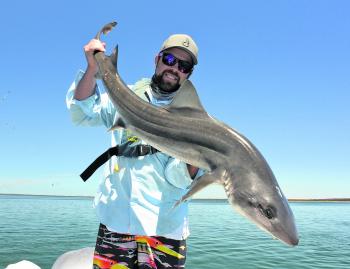
Nathan Williams found a stonking gummy at Montague.
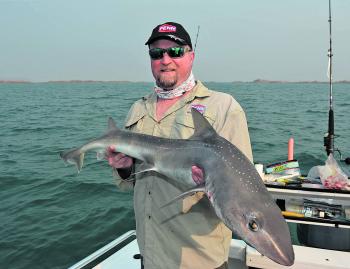
Clinton Howe with another good Montague gummy.
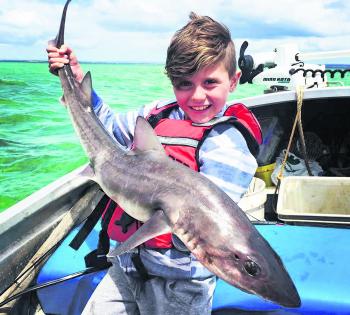
Blake House got into a good one.
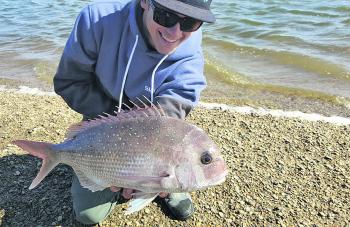
Jarvis with a nice land-based snapper from the Shearwater area.
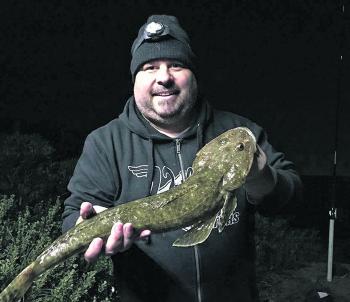
Owen Davies with a big flatty taken off a Burnie Beach.
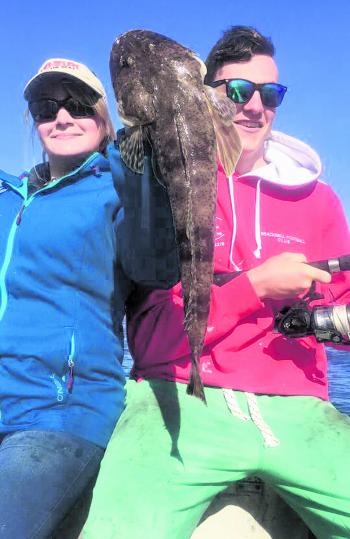
Summer season is flathead season.
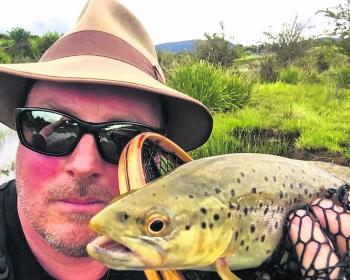
Slow flowing streams and insects mean good success.
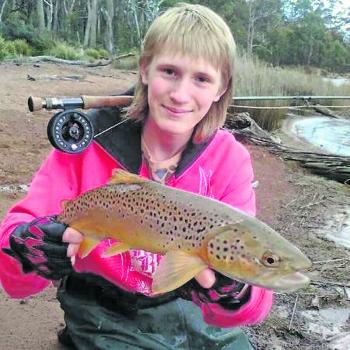
Conner Evan found his fish with a Hardy 6 weight.
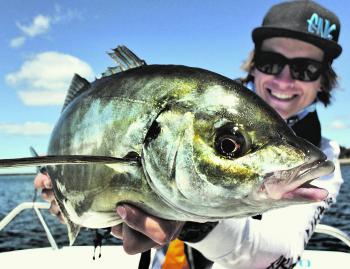
Jarvis Wall has been finding some good trevally on the Northwest Coast.
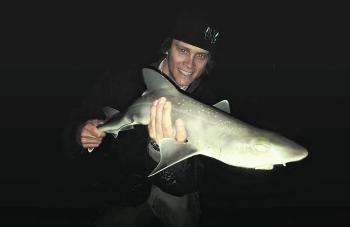
Jarvis with a beach-caught gummy shark.
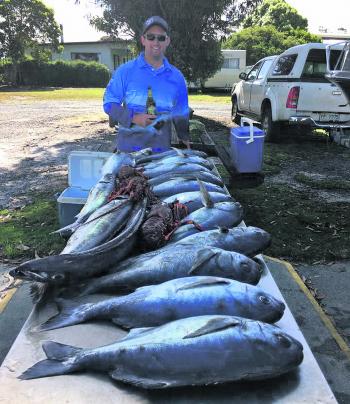
Damien and Graham persevered for great success.
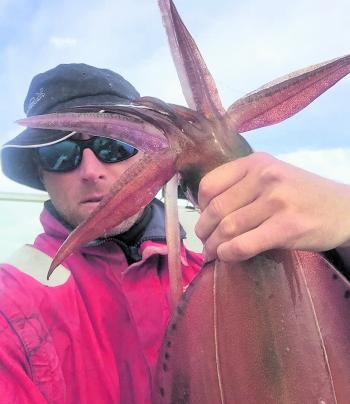
Adam Higgins has been finding some good squid along the coast.
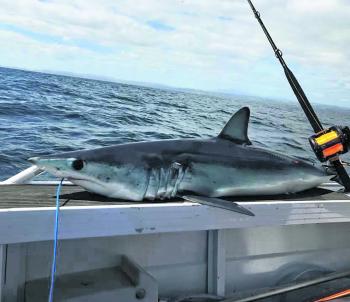
Ayden Bourke knocked this nice mako over with the Penn Squall.
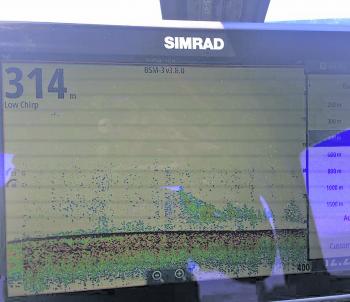
Damo found fish on the big NNS 12 and had to come back to get ‘em on a slack tide.
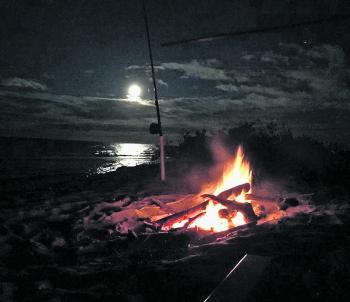
Beach fishing and a fire is a great evening with mates.
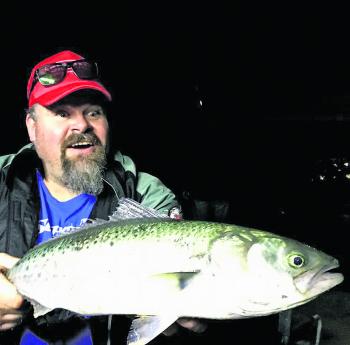
Beach fishing a Burnie gutter found some nice salmon.




